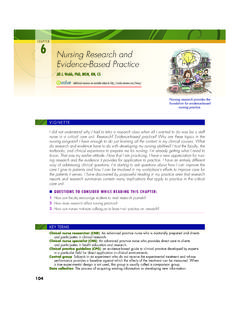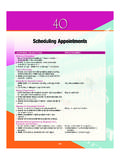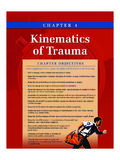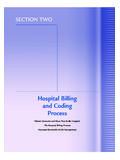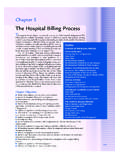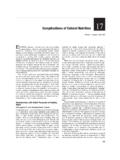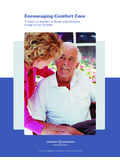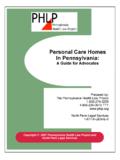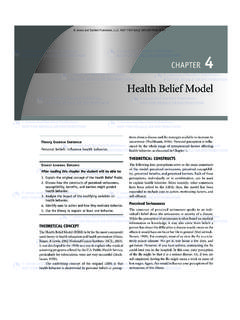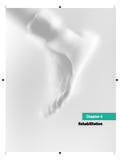Transcription of CHAPTER 13 Nursing Care during Labor and Birth
1 Nursing care duringLabor and BirthOBJECTIVESA fter studying this CHAPTER , you should be able issues that may face the new nurse who cares for women during the intrapartum teaching guidelines for going to the hospital or Birth admission and continuing intrapartum Nursing common Nursing procedures used when caring for women during the intrapartum Nursing priorities when assisting the woman to give Birth under emergency therapeutic communication skills to care of the intrapartum woman and her the Nursing process to care of the woman experiencing false or early the Nursing process to care of the woman and her significant others during the intra-partum to your Student CD-ROM for Review Questions keyed to these A pregnancy that ends before 20 weeks ges-tation, either spontaneously (miscarriage) or a lay term for spontaneous abortion thatis being more frequently used by health Artificial rupture of the membranes (am-niotic sac).
2 Caput Succedaneum Area of edema over the pre-senting part of the fetus or newborn that results frompressure against the cervix (usually called caput).Crowning Appearance of the fetal scalp or presentingpart at the vaginal Abbreviation for estimated date of delivery;alsomay be abbreviated EDB(estimated date of Birth ).Episiotomy Incision of the perineum to enlarge thevaginal Microscopic appearance of amniotic fluid re-sembling fern leaves when the fluid is allowed to dryon a microscope slide; also called fern A pregnant woman; also refers to a woman stotal number of pregnancies, including the one inprogress, if A woman who has given Birth after two or morepregnancies of at least 20 weeks gestation; also informallyused to describe a pregnant woman before the Birth of hersecond Paper Paper used to test pH; helps determinewhether the amniotic sac has Cord Umbilical cord around the fetal A woman who has not completed a pregnancy toat least 20 weeks A woman who has given Birth after a pregnancy of atleast 20 weeks gestation; also designates the number of awoman s pregnancies that have ended after at least 20 weeks gestation.
3 (A multifetal gestation, such as twins, is consideredone Birth when calculating parity.)Primipara A woman who has given Birth after a pregnancyof at least 20 weeks gestation; also used informally to de-scribe a pregnant woman before the Birth of her first of the woman and her family during Labor and Birth isa rewarding yet demanding specialty within Nursing . Thebirth of a baby is more than a physical event. Birth has deeppersonal and social significance for the family, whose rolesand relationships are forever altered by this nurse must support natural physical processes, pro-mote a meaningful experience for the family, and be alert forcomplications. Additionally, the nurse cares for two clients,one of whom the fetus cannot be observed intrapartum area is typically a happy place, and goodoutcomes for mothers and infants are usual. Most womenhave accepted their pregnancies and look forward to meet-ing their infants.
4 Yet some women have had stressful preg-nancies because of physical and substance abuse, economichardship, unsupportive personal relationships, and otherproblems (see CHAPTER 24).ISSUES FOR NEW NURSESNew nurses and Nursing students often approach care of la-boring women with apprehension. They may face severalcommon issues when caring for families during Associated with BirthWorking with people in pain is difficult, and most nurses feelcompelled to relieve pain promptly. Yet pain is expected inlabor and cannot always be eliminated. Some women chooseto have unmedicated births. Helping the woman manage thepain of Birth is a critical part of Nursing care , and manynurses find this to be the most creative aspect of their and Negative ExperiencesThe nurse who has never given Birth may feel inadequate tocare for laboring women, even though the same nurse rarelythinks that experiencing a fracture is necessary to care forsomeone with that problem.
5 Nursing skills needed by theintrapartum nurse are basic: observation, critical thinking,problem solving, therapeutic communication, comfort pro-motion, empathy, and common also may be anxious because of their own difficult ex-periences during Birth . They must be careful not to convey neg-ative attitudes to the laboring woman and her significant follows its own timetable, even with efforts to man-age it. Some nurses find the uncertain nature of an intra-partum area troubling, whereas others find it exciting. Someoccurrences cannot be predicted or explained. In addition,the number of women needing care and the levels of carethey require can change intimate nature of intrapartum care and its sexual over-tones make some nurses uncomfortable. They may feel thatthey are intruding on a private male nurse often is anxious about this aspect of in-trapartum care . Although he may have cared for other fe-male clients, his care rarely has been so focused on the re-productive system.
6 He often wonders whether a woman smale partner will accept him as a care male nurses and female nurses should maintainprofessional conduct and take cues from the couple. If thecouple wants privacy, the nurse should intervene only asneeded to assess the woman and fetus. In more advanced la-bor, both partners often welcome the presence of a compe-tent, caring nurse of either TO THE Birth CENTERThe Decision to Go to the Hospital or Birth CenterDuring the last trimester, the woman needs to know whenshe should go to the hospital or Birth center. Factors to con-sider include:Number and duration of any previous laborsDistance from the hospitalAvailable transportationChild care needsNurses instruct women to distinguish between false andtrue Labor . Nurses teach guidelines for going to the birthcenter and reinforce those given by the physician or nurse-midwife ( Women Want to Know: When to Go to the Hos-pital or Birth Center ).
7 Not everyone has a typical Labor , soa woman should be encouraged to go to the Birth center ifshe is uncertain or has other care during Labor and BirthCHAPTER 13267 WOMEN When to Go to the Hospital or Birth CenterThese are guidelines for providing individualized instructionto women about when to enter the hospital or Birth A pattern of increasing regularity, frequency,duration, and Regular contractions, 5 minutes apart, for1 hourMultipara Regular contractions, 10 minutes apart,for 1 hourRuptured membranes A gush or trickle of fluid from thevagina should be evaluated, regardless of whether con-tractions are Bright-red bleeding should be evaluatedpromptly. Normal bloody show is thicker, pink or dark red,and mixed with fetal movement If you notice a substantial de-crease in the baby s movement, notify your physician ornurse-midwife or come to the Labor concerns These guidelines cannot cover all situa-tions and do not replace specific instructions given to youby your Birth attendant.
8 Therefore please go to the hospi-tal for evaluation of any concerns and feelings that some-thing may be Responsibilities during AdmissionThe two Nursing priorities when the woman arrives at thebirth center are to (1) establish a therapeutic relationshipand (2) assess the condition of the mother and A THERAPEUTIC RELATIONSHIPThe nurse must quickly establish a therapeutic relationshipwith the woman and her significant other. The woman s firstimpression influences her perception of the quality of herentire Birth THE FAMILY FEEL warmgreeting makes the woman and her significant other feel val-ued. Even if the unit is busy, the nurse should communicateinterest, friendliness, caring, and competence. People un-derstand if the nurse is busy, but they do not understandrudeness and insensitivity to their often encounter women who speak a languageother than English. Arranging for a culturally acceptable in-terpreter who is fluent in the woman s language makes thewoman and her family feel welcome and promotes safetybecause it enhances understanding among the woman, herfamily, and the nurse.
9 When caring for a woman who has not had prenatal care orchildbirth classes, which are behaviors that most nursesvalue, the nurse must not be judgmental in either words oractions. The woman s priorities and values may be differentfrom those of the nurse, but she deserves the same respect,support, and care as the woman who made every prepara-tion for her baby s FAMILY EXPECTATIONS of their number of children, womenand their partners have expectations about the Birth experi-ence. The partners may have studied their options exten-sively and planned a Birth that best fits their ideals. Thosewho have not made specific plans also have expectationsshaped by contact with relatives and friends and previousbirth experiences. A couple may want to repeat a previoussatisfying experience or avoid repeating a poor one part of a past Birth has negatively influ-enced the couple s impression of the entire the first en-counter, the nurse should convey confidence and optimismin the woman s ability to give Birth and the ability of hersignificant other to support her.
10 Women having their firstbaby may be overwhelmed by the power of normal laborcontractions. The nurse can reassure these women that in-tense contractions are normal in active Labor while helpingthem manage contractions and watching for true problems. Think about the different perspectives implied by the phrasesgive birthand be woman who gives Birth is anactive and able participant; she is the principal action , the language of be deliveredimplies that thewoman is passive. The nurse might ask Who will attend youas you give Birth ? rather than Who will deliver your baby? ASSIGNING A PRIMARY onenurse give care during all of Labor is ideal but often unreal-istic. However, changes in caregivers should be as limited aspossible. The woman should know the name of and what to268 PART IIIThe Family during BirthEstablishing a Therapeutic RelationshipSandra Hall is a Nursing student assigned to the intrapartumunit.


